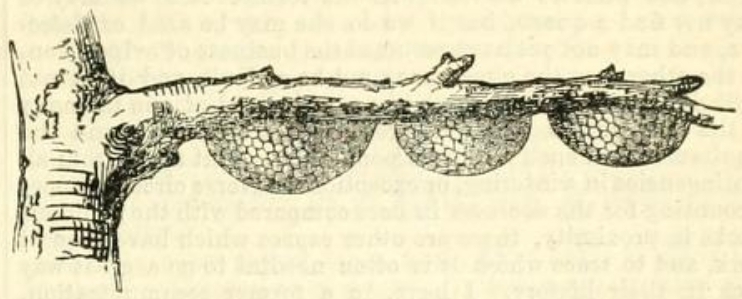[page] 301
[...]
"Some half dozen years ago I received from Mr. Charles Darwin, the distinguished naturalist, a few specimens of bees named Apis testacea (Smith), together with two pieces of their comb. Although these had been brought by Mr. Alfred R. Wallace, the celebrated traveller and author of "The Malay Archipelago," just published, from the island of Timor in the Eastern Archipelago, I believe them to be the same as those which are indigenous in Borneo, so that there appears little reason to doubt that these are the bees referred to by Mr. St. John. On examination I found them half as long again as Apis mellifica, and their brood comb proportionably thicker. They were in fact, a variety of the magnificent Apis dorsata, which is described as flourishing abundantly throughout the great Indian peninsula, from Cape Comorin to the Himalayas, as well as in Ceylon.
Mr. Darwin subsequently introduced me to Mr. Wallace, to whom I am indebted for the following particulars:—"In Borneo and Timor the wax forms an important article of commerce. The combs hang on the under side of horizontal limbs of lofty trees, often one hundred feet from the ground.

"I have seen three together as above, and they are often four feet in diameter. The natives of Timor I have seen take them. They climb up a tree carrying a smoke torch made of a split creeper bound up in palm leaves, and hanging by a rope from their waist. They cover up their body and hair carefully, but their arms and legs are bare. The smoke directed on the comb makes the bees fly off in a cloud as the man approaches. He sweeps off the remainder with his hand and then cuts off the comb with a large knife, and lets it down to his companions below by a thin cord. He is all the time surrounded by a cloud of bees, and though the smoke no doubt partly stupefies them, he must be severely stung. While looking on from a considerable distance a few came down and attacked me, and I did not get rid of them till I was half a mile from the place and had caught them all, one by one, in my insect net. The sting is very severe. I should imagine that in Timor the dry season answers to our winter, as the drought is very severe and much of the foliage is deciduous. Eucalypti are the most common trees, and their flowers I suspect supply the bees with their honey. In Borneo combs are placed in a somewhat similar manner, perhaps formed by the same species. The only bee I have seen domesticated in the East is one at Malacca, the natives hang up bamboos and hollow logs for it, but it is, I believe, not a true Apis, as it makes clusters of large oval shells of black wax."
I may add that the Timor bee was named Apis testacea on account of its color, which is very light, and is, in fact, the only point in which it differs from Apis dorsata. When some years ago I compared the specimens in the British Museum, I became impressed with the idea that those which represented Apis testacea were nothing more than newly-hatched and immature specimens of Apis dorsata, and so strongly did I urge my views upon Mr. Smith, that I believe I almost induced him to doubt the correctness of his own nomenclature, until he was afterwards assured by Mr. Wallace himself, that they were really mature and fully-developed adult bees.—A DEVONSHIRE BEE-KEEPER."